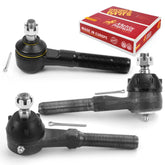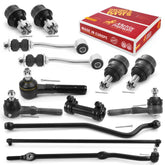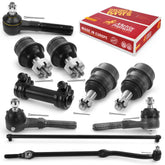Inner vs. Outer Tie Rod Ends: What Sets Them Apart?
The functionality of the vehicle steering system is heavily reliant on the inner and outer tie rod ends. These essential components are responsible for controlling the movement of the front wheels, which in turn guarantees optimal stability, responsiveness, and alignment of the vehicle's front end.
The relation between the inner and outer tie rod ends lies in their collaborative role within a vehicle's steering system. Together, they help translate the driver's steering input into the controlled movement of the front wheels. Here's how they work together:
-
Steering Input Transmission:
When the driver turns the steering wheel, the motion is transferred to the inner tie rod ends, which are connected to the steering rack. The inner tie rod ends convert the rotational motion of the steering rack into linear motion. -
Connection to Outer Tie Rod Ends:
The linear motion generated by the inner tie rod ends is then transmitted to the outer tie rod ends through the threaded connections or ball joints that link them. This connection allows the motion to be transmitted from the inner components of the steering system to the outer components near the wheel knuckles. -
Control of Wheel Movement:
The outer tie rod ends, being connected to the steering knuckles, transmit the linear motion from the inner tie rod ends to the wheels. As the outer tie rod ends move, they push or pull the steering knuckles, which in turn control the turning of the front wheels. -
Alignment and Steering Angle:
The combination of inner and outer tie rod ends also plays a significant role in determining the alignment settings of the vehicle. Proper alignment ensures that the wheels are positioned at the correct angles to maintain stability, even tire wear, and responsive steering. The length of the tie rod ends can be adjusted to set the toe alignment, affecting the angle at which the front wheels point relative to each other.
To ensure safe and efficient driving, it's crucial to have the correct tie rod ends. The inner tie rod ends play a critical role in translating steering input into linear motion, which is then transferred to the outer tie rod ends. The outer tie rod ends are responsible for controlling the movement of the front wheels, ensuring accurate response to the driver's steering commands and proper alignment. For the best tie rod ends selection, visit Metrix Premium Chassis Parts’ website. Tie rod ends’ coordinated functioning is important for your vehicle to respond accurately to your steering commands while maintaining proper alignment for safe and efficient driving. To make the right choice for inner and outer tie rod ends, visit https://metrixpremiumparts.com/.









